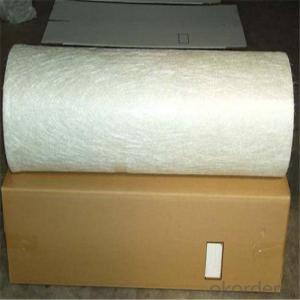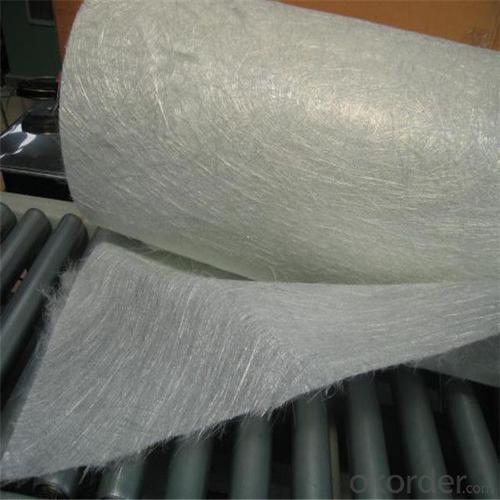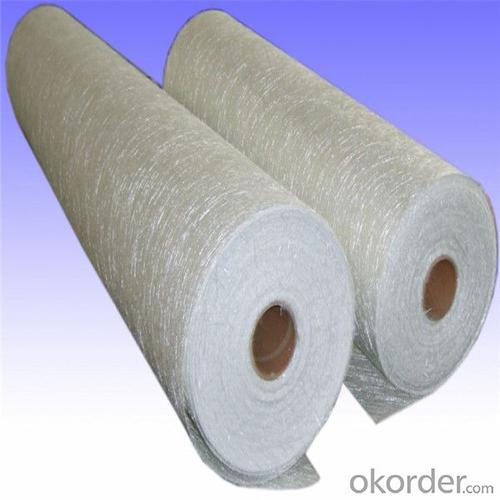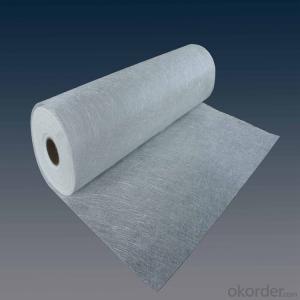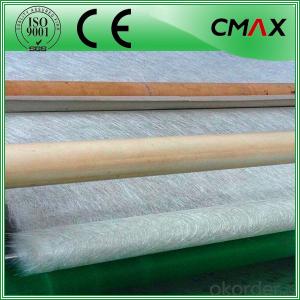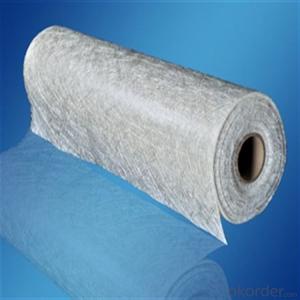Fiberglass Chopped Strand Mat Powder for Boats
- Loading Port:
- Tianjin
- Payment Terms:
- TT OR LC
- Min Order Qty:
- 100 m.t.
- Supply Capability:
- 100000 m.t./month
OKorder Service Pledge
OKorder Financial Service
You Might Also Like
Quick Details
| Technique: | Chopped Strand Fiberglass Mat (CSM) | Dimensions: | 225g/m2-900g/m2 | Fiberglass Type: | E-Glass |
| Place of Origin: | China (Mainland) | Brand Name: | cnbm | Model Number: | 300G-900G |
| moisture: | ≤0.2% | combustion content: | 2.1-6.3% | binder type: | emulsion or powder |
| width: | 1040,1270,2080mm |
Packaging & Delivery
| Packaging Details: | plastic bag then carton then pallet |
| Delivery Detail: | 15 days after payment |
Advantage
1. Chopped strand mat is made up from fiberglass chopped strands bonded with powder binder or emulsion binder
2. Wet out faster and easy of handling
3. Good choppability
4.thickness uniformity
Apllication
fiberglass chopped strand mat
It is used for processing and manufacturing FRP products with getting through hand lay up process, filament winding process and press molding. Typical products is including bathroom accessories, pipe, building material, automobile, furniture, vessel, cooling towers and other FRP products
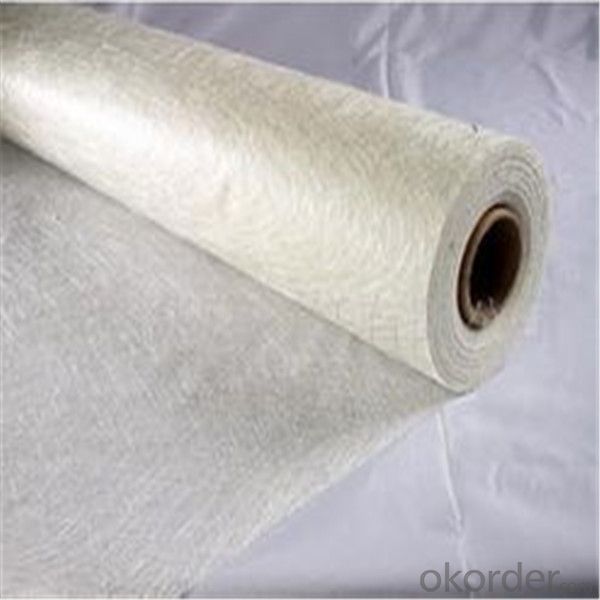


- Q: How is fiberglass chopped strand used in the consumer goods industry?
- Fiberglass chopped strand is widely used in the consumer goods industry due to its versatile properties and numerous applications. It is primarily utilized in the manufacturing of various consumer goods to enhance their strength, durability, and overall performance. One common application of fiberglass chopped strand in the consumer goods industry is in the production of plastic products. By adding the chopped strands to the plastic matrix, it significantly improves the strength and rigidity of the final product. This is particularly beneficial for items such as automotive parts, electrical enclosures, and furniture components, where high strength is required to withstand heavy loads or external impacts. Additionally, fiberglass chopped strand is used in the production of appliances such as refrigerators, washing machines, and ovens. These appliances often require heat resistance and insulation properties, which can be achieved by incorporating chopped strands into their construction. The fiberglass reinforcement provides enhanced thermal stability, allowing the appliances to withstand high temperatures without deformation or structural damage. Another important application of fiberglass chopped strand in the consumer goods industry is in the manufacturing of sporting goods and recreational equipment. It is commonly used in the production of items like surfboards, kayaks, helmets, and bicycles, where the strength-to-weight ratio is crucial. The addition of chopped strands to the composite materials used in these products enhances their strength and resilience, making them more durable and reliable during intense physical activities. Furthermore, fiberglass chopped strand finds extensive use in the production of various household items, such as bathtubs, shower enclosures, sinks, and countertops. These products require resistance to moisture, chemicals, and impact, which can be achieved by incorporating chopped strands into their composite materials. The fiberglass reinforcement ensures that these consumer goods maintain their structural integrity and aesthetic appeal over time. In conclusion, fiberglass chopped strand plays a vital role in the consumer goods industry by providing enhanced strength, durability, and performance to a wide range of products. Its applications are diverse, spanning from plastic products, appliances, and sporting goods to household items. With its unique properties, fiberglass chopped strand is an essential component in the manufacturing process, ensuring that consumer goods meet the demands of modern consumers for high-quality and long-lasting products.
- Q: Can fiberglass chopped strand be used in filtration applications?
- Yes, fiberglass chopped strand can be used in filtration applications. It is commonly used as a filtration media due to its high strength, chemical resistance, and ability to capture and retain solid particles in various filtration processes.
- Q: Can fiberglass chopped strand be used in the production of construction panels?
- Construction panels can utilize fiberglass chopped strand as a reinforcement material, resulting in enhanced structural integrity and durability. This material is composed of randomly oriented glass fibers that are bound together with a binder. By mixing these strands with various resins, such as polyester or epoxy, a composite material is formed that possesses strength, lightness, and resistance to environmental factors. Incorporating fiberglass chopped strand into the production process of construction panels improves their strength, stiffness, and resistance to bending and cracking. Additionally, it enhances impact resistance and dimensional stability, ensuring the panels can withstand different loads and environmental conditions. Moreover, fiberglass chopped strand contributes to the fire resistance and thermal insulation properties of the panels. The glass fibers act as a barrier against heat transfer, reducing the risk of fire spreading and improving energy efficiency. To summarize, utilizing fiberglass chopped strand in the manufacturing of construction panels offers numerous advantages, including increased strength, durability, fire resistance, and thermal insulation. Therefore, it is a suitable material choice for the production of these panels.
- Q: Is fiberglass chopped strand suitable for aerospace applications?
- Fiberglass chopped strand is generally not suitable for aerospace applications. While fiberglass is a versatile and cost-effective material widely used in various industries, including automotive and construction, its properties may not meet the stringent requirements of aerospace applications. Aerospace applications demand materials with exceptional strength-to-weight ratios, high temperature resistance, low thermal expansion, excellent fatigue resistance, and other specific characteristics. These requirements often necessitate the use of advanced composite materials such as carbon fiber or aramid fiber reinforced polymers. Although fiberglass chopped strand exhibits good tensile strength and corrosion resistance, it falls short in other critical areas. Its relatively high density and limited thermal stability make it less suitable for aerospace applications, where lightweight materials that can withstand extreme temperatures and harsh environments are essential. Moreover, aerospace components often require precise engineering and tight tolerances, which may be challenging to achieve with fiberglass chopped strand due to its limited dimensional stability and potential for delamination. Therefore, while fiberglass chopped strand may find numerous applications in various industries, it is typically not the material of choice for aerospace applications. Aerospace engineers and manufacturers prefer advanced composite materials with superior performance characteristics to ensure the safety, reliability, and efficiency of aerospace systems.
- Q: Can fiberglass chopped strand be used in the production of aerospace structures?
- Aerospace structures can benefit from the utilization of fiberglass chopped strand. This versatile material possesses numerous advantages for aerospace applications, including a high strength-to-weight ratio, excellent thermal and electrical insulation properties, and resistance to corrosion and chemicals. When it comes to manufacturing composite materials for aerospace, fiberglass chopped strand can be employed. These composites, such as fiberglass-reinforced polymers (FRPs) or fiber-reinforced composites, offer enhanced strength and durability while remaining lightweight. This characteristic is particularly crucial in aerospace applications where reducing weight is essential. Fiberglass chopped strand finds utility in reinforcing various components within aerospace structures. These components include fuselage sections, wings, landing gear, interior panels, and engine parts. Techniques like filament winding, resin transfer molding, or hand lay-up can incorporate this material into the manufacturing process. Moreover, fiberglass chopped strand can be tailored to meet specific industry requirements. For instance, it can be customized to exhibit flame retardancy, low smoke emission, or high temperature resistance. This adaptability ensures that the material adheres to the stringent safety standards and performance criteria of the aerospace industry. In conclusion, the strength, lightweight properties, and resistance to environmental factors make fiberglass chopped strand an effective resource for the production of aerospace structures. Its integration into composite materials can significantly contribute to the overall performance and efficiency of aerospace components.
- Q: Is fiberglass chopped strand compatible with acrylic resin?
- Yes, fiberglass chopped strand is compatible with acrylic resin.
- Q: How is fiberglass chopped strand measured?
- Fiberglass chopped strand is typically measured by its length. The length of the chopped strand refers to the average length of the individual glass fibers within the strand. This measurement is important as it affects the strength and performance of the fiberglass in various applications. Common lengths for chopped strand range from a few millimeters to several centimeters, depending on the intended use. The measurement is usually specified in inches or millimeters, and it is crucial to select the appropriate length based on the specific requirements of the project or product.
- Q: What are the disposal options for fiberglass chopped strand waste?
- There are several disposal options available for fiberglass chopped strand waste. One option is to recycle the waste material. Fiberglass can be recycled by grinding it down and using it as filler material in other products such as concrete or asphalt. This not only helps to reduce the amount of waste going to landfills but also allows for the reuse of the fiberglass. Another disposal option is to incinerate the chopped strand waste. Incineration can be a viable option for disposing of fiberglass waste as it can generate energy from the combustion process. However, it is important to note that incineration should only be done in facilities equipped with proper air pollution control systems to minimize the release of harmful emissions. If recycling or incineration is not feasible, landfill disposal is another option. However, this should be considered as a last resort due to the potential environmental impact. When disposing of fiberglass chopped strand waste in a landfill, it is important to ensure that the waste is properly contained and managed to prevent any potential leaching of hazardous materials. In conclusion, the disposal options for fiberglass chopped strand waste include recycling, incineration, and landfill disposal. It is recommended to prioritize recycling and incineration where possible to minimize the environmental impact of this waste material.
- Q: Is fiberglass chopped strand suitable for the production of sports equipment?
- Yes, fiberglass chopped strand is suitable for the production of sports equipment. Fiberglass is a lightweight and durable material that offers high strength-to-weight ratio, making it an excellent choice for various sports equipment. It provides excellent impact resistance, stiffness, and flexibility, making it suitable for applications such as tennis rackets, hockey sticks, bicycle frames, and surfboards. Additionally, fiberglass is corrosion-resistant and can withstand harsh weather conditions, making it ideal for outdoor sports equipment. Its versatility allows manufacturers to design and produce sports equipment with specific performance requirements, making fiberglass chopped strand an excellent choice for the production of sports equipment.
- Q: What are the typical mechanical properties of fiberglass chopped strand composites?
- Fiberglass chopped strand composites possess several typical mechanical properties, including high strength, stiffness, and dimensional stability. These composites demonstrate outstanding tensile, flexural, and impact strength, rendering them suitable for a wide range of structural applications. Moreover, their high modulus of elasticity ensures exceptional resistance to deformation when subjected to external forces. In addition, these composites have a low density, making them lightweight and perfect for applications that prioritize weight reduction. Furthermore, fiberglass chopped strand composites display excellent fatigue resistance, enabling them to endure repeated loading without significant performance deterioration. Overall, the mechanical properties of fiberglass chopped strand composites make them a versatile material option across various industries such as automotive, aerospace, construction, and marine.
Send your message to us
Fiberglass Chopped Strand Mat Powder for Boats
- Loading Port:
- Tianjin
- Payment Terms:
- TT OR LC
- Min Order Qty:
- 100 m.t.
- Supply Capability:
- 100000 m.t./month
OKorder Service Pledge
OKorder Financial Service
Similar products
Hot products
Hot Searches
Related keywords

